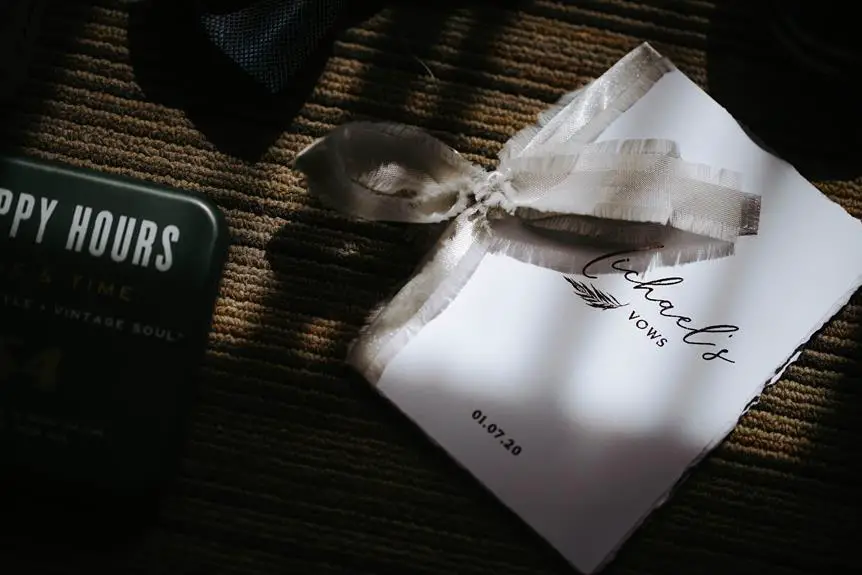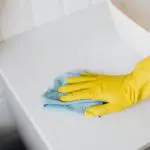Looking to remove lettering from fabric? You've come to the right place. In this guide, you'll discover five straightforward methods to effectively eliminate unwanted lettering from your fabric.
Whether it's heat and peel, rubbing alcohol, lemon juice and salt, acetone or nail polish remover, or using fabric scissors and patching, these techniques will equip you with the skills to master the art of lettering removal from fabric.
Follow these simple steps and say goodbye to unwanted lettering on your favorite fabrics.
Key Takeaways
- Heat-based methods can be used to remove lettering from fabric by using an iron and heat-resistant surface.
- Solvent-based methods, such as rubbing alcohol or acetone, can dissolve adhesive and remove lettering from fabric.
- Natural methods, like using a lemon juice and salt solution, can be effective in removing lettering from fabric.
- If the lettering cannot be removed, the cutting and patching method can be used to remove the lettering by cutting it out and patching the fabric.
Heat and Peel Method
To remove lettering from fabric using the heat and peel method, you'll need to follow these steps:
- Ensure that the fabric is suitable for heat application.
- Protect delicate fabrics by placing a pressing cloth over the lettering.
- Set your iron to the appropriate heat level for the fabric type—cotton typically requires a higher setting than synthetic fabrics.
- Once the iron is heated, lay the fabric on a flat, heat-resistant surface and cover the lettering with the pressing cloth.
- Press the iron onto the cloth, holding it in place for 10-15 seconds.
- Lift the iron and gently try to peel off the letters. If they don't come off easily, reapply the iron and test again.
- Be cautious not to use too much force, as this might damage the fabric.
- After removing the letters, allow the fabric to cool before inspecting the area.
- If there's any adhesive residue, gently dab it with a cotton ball or cloth dampened with rubbing alcohol.
- This method helps maintain fabric protection while effectively removing unwanted lettering.
Rubbing Alcohol Technique
The rubbing alcohol technique offers a simple and effective way to remove lettering from fabric. This method is highly effective on fabrics where heat and peel may not be suitable, such as delicate or synthetic materials. To use this technique, dampen a cotton ball or soft cloth with rubbing alcohol and gently rub it onto the lettering. The alcohol works to break down and dissolve the adhesive used in the lettering, making it easier to remove. It's important to test the rubbing alcohol on a small, inconspicuous area of the fabric first to ensure it doesn't cause any damage or discoloration.
When considering the effectiveness of rubbing alcohol, it's important to note that it may not work as well on certain types of lettering or fabrics, so it's always wise to test a small area first. If rubbing alcohol doesn't effectively remove the lettering, there are alternative fabric cleaning methods to consider, such as using a specialized fabric adhesive remover or seeking professional help.
Always follow up the rubbing alcohol treatment with a thorough laundering of the fabric to remove any residual alcohol or adhesive.
Lemon Juice and Salt Solution
You can create a lemon juice and salt solution to effectively remove lettering from fabric. This natural alternative is a great option for stain removal techniques, especially for those who prefer to avoid using harsh chemicals. The acidity of the lemon juice combined with the abrasive texture of salt can help lift and fade the lettering without damaging the fabric. Here's a simple recipe to make the solution at home:
| Ingredients | Measurements |
|---|---|
| Lemon juice | 1/4 cup |
| Salt | 2 tablespoons |
| Water | 2 cups |
To create the solution, mix the lemon juice, salt, and water in a bowl. Stir the ingredients until the salt is dissolved. Once the solution is ready, apply it directly to the lettering on the fabric. Gently massage the solution into the fabric using a soft-bristled brush or cloth. Allow the solution to sit on the fabric for 15-30 minutes, then rinse it with cold water. Finally, wash the fabric as usual. This method may need to be repeated for stubborn stains, but it offers a gentle and natural approach to removing lettering from fabric.
Use of Acetone or Nail Polish Remover
For fabric with stubborn lettering, acetone or nail polish remover can be used to dissolve and remove the remaining residue. When using acetone or nail polish remover on fabric, it's important to proceed with caution to avoid damaging the fabric. Here are some steps to follow when using acetone or nail polish remover:
- Test on a Hidden Area: Before applying acetone or nail polish remover to the visible area of the fabric, test it on a hidden or inconspicuous area to ensure it doesn't cause discoloration or damage.
- Choose Fabric Friendly Nail Polish Removers: Look for nail polish removers that are labeled as gentle or fabric-friendly. These removers are formulated to be less harsh on fabrics, reducing the risk of damage.
- Acetone Alternatives, Safe Options: If you prefer to avoid using acetone, consider using alternative solvents such as rubbing alcohol or non-acetone nail polish removers. These options can be milder and less likely to cause damage to the fabric.
- Blotting and Rinsing: After applying the acetone or nail polish remover, gently blot the area with a clean cloth to lift the lettering residue. Then, rinse the fabric thoroughly with water to remove any remaining solvent and residue.
Fabric Scissors and Patching Method
Consider using a sharp pair of fabric scissors to carefully cut out the lettering from the fabric, followed by the patching method to seamlessly cover the area. When using fabric scissors for this purpose, ensure they're sharp and have a pointed tip for precision. Carefully snip around the edges of the lettering, ensuring not to cut through the surrounding fabric. After removing the lettering, assess the area for any frayed edges and trim them neatly.
Next, for the patching method, select a piece of fabric that closely matches the color and texture of the original fabric. Cut a patch that's slightly larger than the area where the lettering was removed. Place the patch on the backside of the fabric and carefully hand-stitch it into place using a matching thread. Use small, discreet stitches to secure the patch, ensuring that it blends seamlessly with the surrounding fabric.
This fabric repair technique, when done with precision and attention to detail, can effectively remove unwanted lettering from fabric while maintaining its integrity. Mastery of these sewing techniques will empower you to skillfully address and rectify lettering on various fabric surfaces.
Frequently Asked Questions
Can These Methods Be Used on Delicate Fabrics Like Silk or Lace?
Yes, these methods can be used on delicate fabrics like silk or lace. When removing lettering from delicate fabrics, it's important to follow proper silk care guidelines and use gentle techniques to avoid damaging the fabric.
Will Any of These Methods Cause Damage or Discoloration to the Fabric?
When removing lettering from fabric, consider potential risks like color fading and fabric damage. Different fabric types may react differently to removal methods. Test a small, inconspicuous area first to avoid any unwanted discoloration or damage.
Can These Techniques Be Used to Remove Iron-On Lettering or Patches?
Yes, you can use these techniques to remove iron-on lettering or patches. Heat transfer, embroidery, vinyl, and appliqué can be removed using these methods. Follow the instructions carefully to avoid damaging the fabric.
Are There Any Safety Precautions or Potential Hazards to Be Aware of When Using These Methods?
When using these methods, be sure to take safety precautions. Proper ventilation and protective gear are essential to avoid potential hazards from chemical reactions. Check fabric compatibility and consider professional assistance and emergency procedures if needed.
Are There Any Specific Types of Lettering or Ink That These Methods May Not Effectively Remove From Fabric?
When removing lettering from fabric, certain types of ink like permanent markers may not be effectively removed. Consider the fabric material and the type of ink used before attempting removal. Always follow safety precautions to avoid potential hazards.
- Recycling Nonwoven Fabrics: Is It Possible? - July 11, 2025
- Recycling Nonwoven Fabrics: Is It Possible? - July 11, 2025
- Recycling Nonwoven Fabrics: Is It Possible? - July 11, 2025







